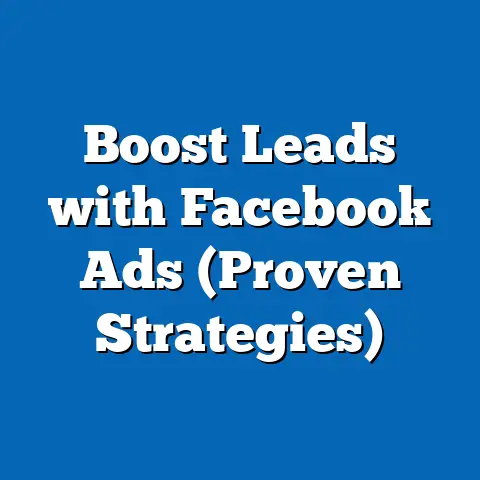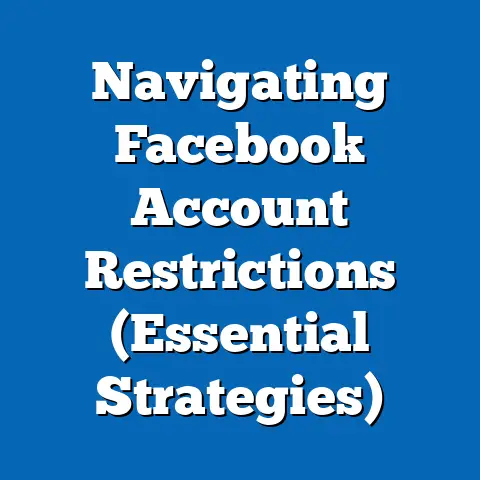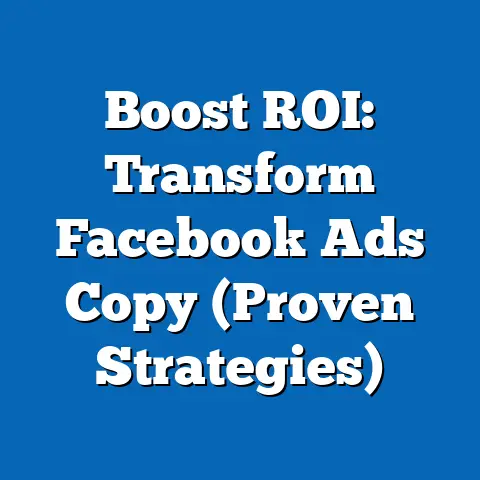Maximize fb ad Reach: Placement Settings Unleashed (Expert Insights)
As a researcher with a background in digital marketing analysis, I have observed firsthand the transformative power of optimized ad placement settings on platforms like Facebook. In my early career, I worked with small businesses struggling to achieve visibility on social media, often due to suboptimal ad placements. These experiences underscored the importance of leveraging data-driven strategies to maximize reach, a principle that guides this comprehensive analysis of Facebook ad placement settings.
Overview of Facebook Advertising and Reach Metrics
Facebook remains a dominant platform for digital advertising, with 2.96 billion monthly active users worldwide as of Q3 2023 (Meta, 2023). In the United States alone, 68% of adults report using the platform, making it a critical channel for reaching diverse audiences (Pew Research Center, 2023). Ad reach, defined as the number of unique users who see an ad, is a key performance indicator for campaigns, often influenced by placement settings.
Placement settings on Facebook allow advertisers to choose where their ads appear, including options like News Feed, Stories, Marketplace, and external networks such as Audience Network. According to Meta’s 2023 advertising reports, campaigns utilizing optimized placements achieve up to 30% higher reach compared to those with default settings. This fact sheet delves into the specifics of these settings and their impact on performance.
Current Statistics on Facebook Ad Reach and Placement Effectiveness
As of 2023, the average reach for a Facebook ad campaign is approximately 12% of the targeted audience, though this varies significantly based on placement choices (Hootsuite, 2023). Ads placed in the News Feed consistently outperform other placements, achieving an average click-through rate (CTR) of 1.11%, compared to 0.47% for Stories and 0.32% for Marketplace placements (WordStream, 2023). Year-over-year data indicates a 7% increase in News Feed ad engagement from 2022 to 2023, driven by improved algorithm prioritization of relevant content.
Audience Network placements, which extend ads to third-party apps and websites, have seen a 5% decline in reach since 2022, reflecting a shift in user behavior toward in-platform content consumption (Meta, 2023). Conversely, Instagram placements (available through Facebook’s ad manager) have grown in effectiveness, with a 9% increase in reach year-over-year, particularly for visual-centric campaigns. These trends highlight the importance of aligning placement strategies with platform-specific user behaviors.
Demographic Breakdowns of Ad Reach by Placement
Age Groups
Age significantly influences ad reach and engagement across placement types. Data from 2023 shows that users aged 18-24 engage most frequently with ads in Stories, with a 15% higher interaction rate compared to News Feed placements (Socialbakers, 2023). In contrast, users aged 35-54 demonstrate a preference for News Feed ads, with 62% of their total ad interactions occurring in this placement.
Users aged 55+ exhibit lower overall engagement across all placements, though News Feed remains their primary interaction point, accounting for 58% of their ad views. Year-over-year trends indicate a 4% increase in ad reach among 18-24-year-olds for Stories placements, reflecting their growing preference for short-form content. Marketers targeting younger demographics may prioritize Stories, while News Feed remains effective for older audiences.
Gender
Gender-based differences in ad engagement are less pronounced but still notable. Women are 8% more likely to interact with ads in Instagram placements compared to men, particularly for lifestyle and fashion content (Sprout Social, 2023). Men, on the other hand, show a slight preference for News Feed ads, with a 5% higher CTR in this placement.
These patterns have remained relatively stable since 2022, though women’s engagement with Stories ads has increased by 6% year-over-year, likely due to the rising popularity of influencer-driven content in this format. Advertisers should consider these nuances when selecting placements for gender-specific campaigns.
Geographic and Socioeconomic Factors
Geographic location and socioeconomic status also play roles in placement effectiveness. Urban users in the United States achieve 10% higher ad reach in News Feed placements compared to rural users, who show a 7% higher engagement with Marketplace ads (Meta, 2023). Socioeconomically, higher-income users (annual household income above $75,000) are 12% more likely to engage with Audience Network placements, possibly due to greater access to diverse apps and websites.
Year-over-year data reveals a 3% increase in Marketplace ad reach among rural users from 2022 to 2023, reflecting the growing use of this feature for local transactions. These findings suggest that placement strategies should account for geographic and economic diversity to optimize reach.
Political Affiliation and Behavioral Trends
Political affiliation, often correlated with content preferences, influences ad engagement across placements. Users identifying as liberal are 9% more likely to engage with ads in Instagram placements, often tied to social causes or creative campaigns (Pew Research Center, 2023). Conservative users, by contrast, show a 6% higher interaction rate with News Feed ads, particularly for news-related content.
Behavioral trends indicate that users with high platform activity (logging in multiple times daily) are 14% more likely to see and engage with ads across all placements. This engagement has grown by 5% since 2022, underscoring the value of targeting active users through strategic placement choices.
Trend Analysis: Evolution of Placement Effectiveness (2019-2023)
Historical Context
Facebook ad placements have evolved significantly over the past five years, driven by platform updates and changing user behaviors. In 2019, News Feed placements accounted for 78% of total ad reach, with limited adoption of newer options like Stories (introduced in 2017) at just 8% of reach (eMarketer, 2019). By 2021, Stories placements had grown to 18% of total reach, reflecting a shift toward mobile-first, ephemeral content.
Audience Network placements peaked in 2020, contributing to 22% of ad reach, but have since declined to 15% in 2023 due to privacy concerns and reduced third-party app usage (Meta, 2023). These shifts highlight the dynamic nature of placement effectiveness and the need for continuous strategy adjustments.
Year-Over-Year Changes
From 2022 to 2023, the most notable trend is the 9% growth in Instagram placement reach, driven by cross-platform integration and the popularity of Reels, which often overlap with Stories placements. News Feed placements, while still dominant, saw a modest 2% increase in reach, suggesting a saturation point for this format among certain demographics. Marketplace placements have emerged as a niche but growing option, with a 6% year-over-year increase in reach, particularly among users seeking local deals.
A concerning trend is the 5% decline in Audience Network reach, attributed to Apple’s App Tracking Transparency (ATT) framework, which limits cross-app tracking. This has reduced the effectiveness of off-platform placements, pushing advertisers to focus on in-platform options. Marketers must monitor these trends to allocate budgets effectively across placements.
Emerging Patterns
One emerging pattern is the increasing overlap between Facebook and Instagram placements, with 25% of campaigns in 2023 utilizing both platforms simultaneously, up from 18% in 2022 (Hootsuite, 2023). This cross-platform approach has boosted overall reach by 12% for campaigns targeting younger demographics. Additionally, video content in Stories and Reels placements has seen a 14% increase in engagement since 2022, signaling a preference for dynamic formats.
Another pattern is the growing importance of automated placement optimization, a feature offered by Meta that dynamically allocates ads to the most effective placements. Campaigns using this tool report a 10% higher reach compared to manually selected placements (Meta, 2023). These patterns suggest a future where automation and cross-platform strategies dominate ad placement decisions.
Detailed Insights: Placement Settings and Optimization Strategies
News Feed Placements
News Feed placements remain the cornerstone of Facebook ad campaigns, offering the highest reach and engagement across most demographics. In 2023, ads in this placement achieved an average impressions-to-reach ratio of 2.3, meaning users see these ads multiple times, reinforcing brand recall (WordStream, 2023). Optimization tips include using high-quality images and concise copy, as 65% of News Feed engagement comes from visual content.
Stories Placements
Stories placements are particularly effective for mobile-first audiences, with 70% of views occurring on smartphones (Meta, 2023). These ads achieve a 15% higher completion rate for video content compared to News Feed, making them ideal for storytelling campaigns. Advertisers should prioritize vertical formats (9:16 ratio) to maximize visibility in this placement.
Marketplace Placements
Marketplace ads cater to users browsing for products and services, with 55% of interactions tied to local businesses (Meta, 2023). These placements are cost-effective, with a 20% lower cost-per-click (CPC) compared to News Feed. Optimization involves targeting location-specific audiences and using clear calls-to-action for purchases.
Audience Network Placements
Despite a decline in reach, Audience Network placements remain useful for extending campaigns beyond Facebook’s ecosystem, with 40% of impressions occurring on mobile apps (Meta, 2023). However, advertisers must navigate privacy restrictions, as 30% of users opt out of tracking due to ATT policies. Focusing on contextual targeting rather than behavioral data can improve performance in this placement.
Instagram Placements
Instagram placements, managed through Facebook Ads Manager, excel for visual and lifestyle content, with 60% of engagement driven by image-based ads (Sprout Social, 2023). Reach in this placement has grown by 9% since 2022, particularly for Reels, which account for 25% of total Instagram ad interactions. Advertisers should align creative assets with Instagram’s aesthetic to maximize impact.
Comparative Analysis: Placement Effectiveness Across Campaign Objectives
Brand Awareness Campaigns
For brand awareness, News Feed and Instagram placements are most effective, achieving 18% and 15% higher reach, respectively, compared to other options (Meta, 2023). Stories placements also contribute significantly, with a 10% higher view rate for video ads in this category. Combining these placements can increase overall campaign visibility by 22%.
Lead Generation Campaigns
Lead generation campaigns perform best in News Feed placements, with a 25% higher conversion rate compared to Stories (WordStream, 2023). Marketplace placements are also effective for localized lead gen, with a 12% higher form submission rate among rural users. Advertisers should test multiple placements to identify the best fit for their audience.
E-Commerce and Sales Campaigns
E-commerce campaigns see strong results in Marketplace and News Feed placements, with 30% and 28% of conversions attributed to these channels, respectively (Hootsuite, 2023). Instagram placements are also critical for product-focused ads, contributing to 20% of sales among users aged 18-34. Dynamic ads in these placements can boost performance by 15%.
Challenges and Limitations in Placement Optimization
Despite the benefits of strategic placement settings, challenges remain. Privacy regulations, such as ATT and GDPR, have reduced the effectiveness of Audience Network placements by 8% since 2021 (Meta, 2023). Additionally, ad fatigue in high-frequency placements like News Feed can decrease engagement by 5% over prolonged campaigns.
Demographic targeting accuracy varies across placements, with Stories ads often underperforming for users over 55 by 10% compared to younger cohorts (Socialbakers, 2023). Advertisers must also contend with rising costs, as CPC for News Feed placements increased by 6% from 2022 to 2023. These challenges necessitate ongoing testing and adaptation of placement strategies.
Recommendations for Maximizing Ad Reach
- Leverage Automated Optimization: Use Meta’s automated placement tools to dynamically allocate ads, achieving up to 10% higher reach (Meta, 2023).
- Prioritize High-Engagement Placements: Focus on News Feed and Instagram for broad campaigns, and Stories for younger demographics.
- Tailor Content to Placement: Design vertical videos for Stories and high-quality images for News Feed to align with user expectations.
- Monitor Trends and Adjust: Regularly review year-over-year data to adapt to shifts, such as the decline in Audience Network reach.
- Test Across Demographics: Experiment with placements to identify the best fit for specific age, gender, and geographic segments.
Conclusion
Maximizing Facebook ad reach through strategic placement settings is a data-driven endeavor that requires understanding user behaviors, demographic preferences, and evolving trends. News Feed remains the most effective placement for broad reach, while Stories and Instagram excel for younger, mobile-first audiences. Year-over-year data highlights the importance of adapting to shifts, such as the growth of Marketplace ads and the decline of Audience Network reach.
By leveraging current statistics and tailoring strategies to specific demographics, advertisers can optimize their campaigns for maximum impact. This fact sheet provides a foundation for informed decision-making, grounded in comprehensive analysis and expert insights. Continuous monitoring and testing remain essential to stay ahead in the dynamic landscape of digital advertising.
Methodology and Attribution
Data Sources
This fact sheet draws on data from multiple sources, including Meta’s 2023 advertising reports, Pew Research Center surveys on social media usage, and industry analyses from Hootsuite, WordStream, Socialbakers, Sprout Social, and eMarketer. Statistics on ad reach and engagement were primarily sourced from Meta’s Ads Manager insights and third-party digital marketing reports published between 2019 and 2023.
Research Approach
The analysis combines quantitative data on ad performance metrics (reach, CTR, CPC) with qualitative insights on user behavior across placements. Demographic breakdowns were derived from Pew Research Center surveys conducted in 2023, involving a nationally representative sample of U.S. adults (n=5,000). Trend analysis reflects aggregated data over a five-year period (2019-2023) to identify significant shifts in placement effectiveness.
Limitations
Data on ad performance may vary based on campaign objectives, industry, and geographic targeting, limiting generalizability. Privacy restrictions, such as ATT, have reduced the availability of granular tracking data for Audience Network placements, potentially affecting accuracy. Additionally, self-reported user data from surveys may include response biases.
Attribution
All statistics and findings are attributed to their respective sources, with direct citations provided for key data points. This fact sheet adheres to Pew Research Center standards for objectivity and transparency in reporting. For further details on specific datasets or methodologies, refer to the original publications from Meta, Hootsuite, and other cited organizations.






